11.AOP
11.1.什么是AOP(再不影响原有代码的情况下,实现动态增强)
AOP(Aspect Oriented Programming),意为:面向切面编程 ,通过预编译方式和运行期间动态代理实现程序功能的统一维护的一种技术。AOP是OOP的延续,是软件开发中的一个热点,也是Spring框架中的一个重要内容,是函数式编程的一种衍生范型。利用AOP可以对业务逻辑的各个部分进行隔离,从而使得业务逻辑各部分之间的耦合度降低,提高程序的可重用性,同时提高了开发的效率。
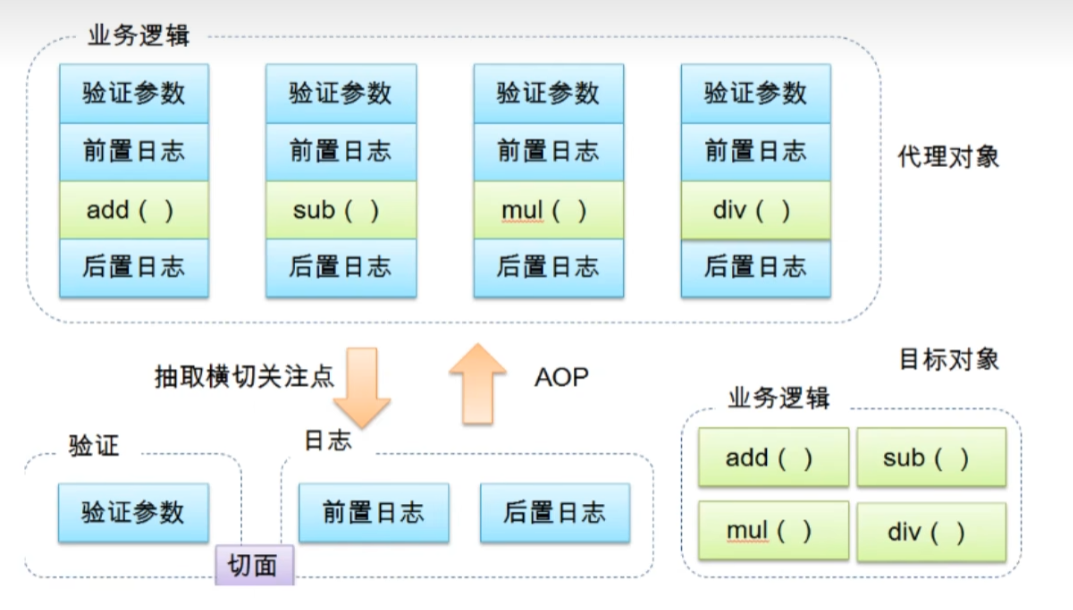
11.2.AOP在Spring中的作用
提供声明式事务;允许用户自定义切面
- 横切关注点:跨越应用程序多个模块的方法或功能。即是,与我们业务逻辑无关的,但是我们需要关注的部分,就是横切关注点。如:日志,安全,缓存,事务等等。
- 切面(ASPECT):横切关注点被模块化的特殊对象。即,它是一个类(也就是log)
- 通知(Advice):切面必须要完成的工作。即,它是类中的方法。(log中的方法)
- 目标(Target):被通知对象。
- 代理(Proxy):向目标对象应用通知之后创建的对象。
- 切入点(PointCut):切面通知执行的“地点”的定义。
- 连接点(JointPoint):与切入点匹配的执行点。
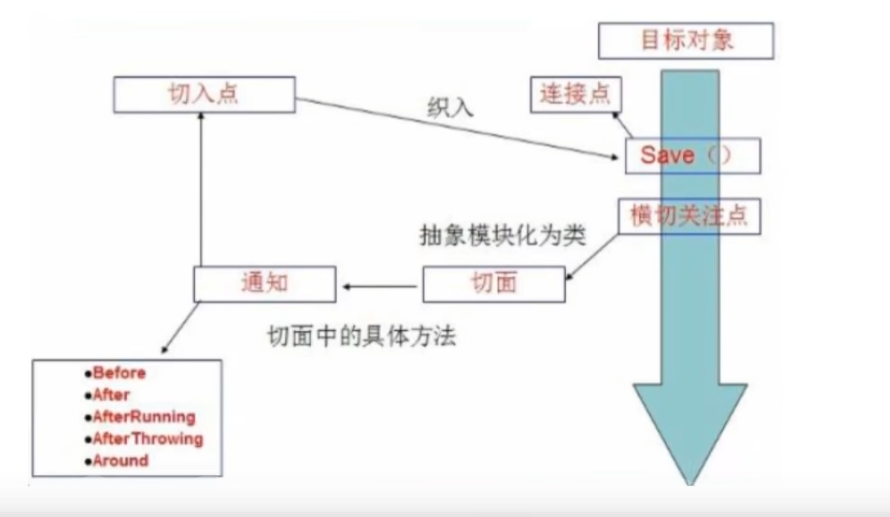
springAOP中,通过Advice定义横切逻辑,Spring中支持5种类型的Advice
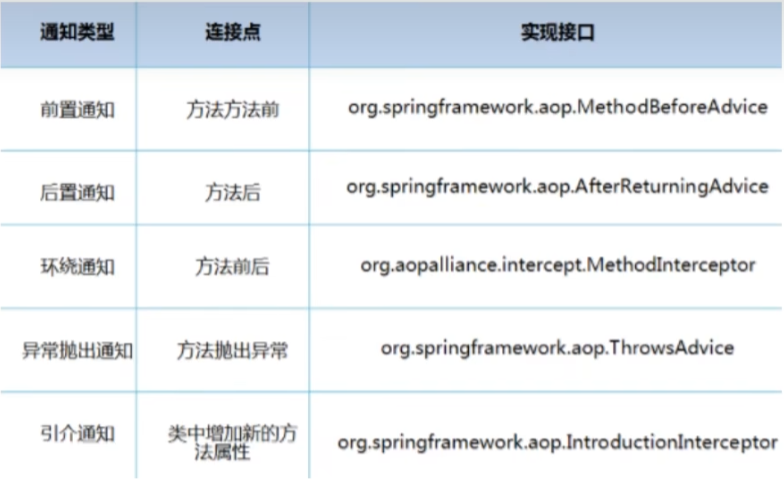
即AOP在不改变原有代码的情况下,去增加新的功能。
11.3.使用Spring实现AOP【面向切面编程】
【重点】使用AOP织入,需要导入一个依赖包
<dependencies>
<dependency>
<groupId>org.aspectj</groupId>
<artifactId>aspectjweaver</artifactId>
<version>1.9.4</version>
</dependency>
</dependencies>
配置AOP需要导入AOP的约束
<?xml version="1.0" encoding="UTF-8"?>
<beans xmlns="<http://www.springframework.org/schema/beans>"
xmlns:xsi="<http://www.w3.org/2001/XMLSchema-instance>"
xmlns:aop="<http://www.springframework.org/schema/aop>"
xsi:schemaLocation="<http://www.springframework.org/schema/beans>
<https://www.springframework.org/schema/beans/spring-beans.xsd>
<http://www.springframework.org/schema/aop>
<https://www.springframework.org/schema/aop/spring-aop.xsd>">
</beans>
11.3.方式一:使用使用原生的SpringAPI接口实现
1.接口
public interface UserService {
public void add();
public void delete();
public void update();
public void select();
}
2.真实角色
public class UserServiceImpl implements UserService{
public void add() {
System.out.println("增加了一个用户");
}
public void delete() {
System.out.println("删除了一个用户");
}
public void update() {
System.out.println("修改了一个用户");
}
public void select() {
System.out.println("查找了一个用户");
}
}
3.日志
//MethodBeforeAdvice:在执行前通知(Advice)
public class Log implements MethodBeforeAdvice {
//Method:要执行的目标对象的方法
//args:参数
//target:目标对象
public void before(Method method, Object[] args, Object target) throws Throwable {
System.out.println(target.getClass().getName()+"的"+method.getName()+"被执行了");
}
}
//AfterReturningAdvice :在执行后通知(Advice)
public class AfterLog implements AfterReturningAdvice {
//returnValue:返回值
public void afterReturning(Object returnValue, Method method, Object[] args, Object target) throws Throwable {
System.out.println("执行了"+method.getName()+"方法,返回的结果为"+returnValue);
}
}
4.ApplicationContext.xml(容器)
<?xml version="1.0" encoding="UTF-8"?>
<beans xmlns="<http://www.springframework.org/schema/beans>"
xmlns:xsi="<http://www.w3.org/2001/XMLSchema-instance>"
xmlns:aop="<http://www.springframework.org/schema/aop>"
xsi:schemaLocation="<http://www.springframework.org/schema/beans>
<https://www.springframework.org/schema/beans/spring-beans.xsd>
<http://www.springframework.org/schema/aop>
<https://www.springframework.org/schema/aop/spring-aop.xsd>">
<!--注册bean-->
<bean id="userService" class="com.itxiaofei.service.UserServiceImpl"/>
<bean id="log" class="com.itxiaofei.log.Log"/>
<bean id="afterlog" class="com.itxiaofei.log.AfterLog"/>
<!--方式一:使用原生的Spring API接口-->
<!--配置AOP:需要导入aop的约束-->
<aop:config>
<!--aop的切入点:pointcut 、expression:表达式,expression(要执行的位置* * * * *)-->
<!--可以配置多个切入点-->
<aop:pointcut id="pointcut" expression="execution(* com.itxiaofei.service.UserServiceImpl.*(..))"/>
<!--执行环绕增加:我们把log这个类切入到上面那个地方-->
<aop:advisor advice-ref="log" pointcut-ref="pointcut"/>
<aop:advisor advice-ref="afterlog" pointcut-ref="pointcut"/>
</aop:config>
</beans>
注意:主要了解如何导入aop的约束,如何配置切入点,以及如何切入!

5.测试文件
public class MyTest {
public static void main(String[] args) {
ApplicationContext context = new ClassPathXmlApplicationContext("ApplicationContext.xml");
//动态代理代理的是接口:注意点
UserService userService = (UserService) context.getBean("userService");
userService.add();
}
}
6.执行结果:

注意(切点表达式)

(..)前*表示:这个包下的所有类的所有方法

11.3方式二:自定义来实现AOP【主要是 切面定义】
1.接口
public interface UserService {
public void add();
public void delete();
public void update();
public void select();
}
2.真实角色
public class UserServiceImpl implements UserService{
public void add() {
System.out.println("增加了一个用户");
}
public void delete() {
System.out.println("删除了一个用户");
}
public void update() {
System.out.println("修改了一个用户");
}
public void select() {
System.out.println("查找了一个用户");
}
}
3.自定义切面
public class DiyPointCut {
public void befor(){
System.out.println("=====输出前执行=====");
}
public void after(){
System.out.println("=====输出后执行=====");
}
}
4.ApplicationContext(容器)
<!--方式二:自定义实现AOP-->
<!--注册bean-->
<bean id="diy" class="com.itxiaofei.diy.DiyPointCut"/>
<aop:config>
<!--自定义切面,ref:要引用的类-->
<aop:aspect ref="diy">
<!--切入点-->
<aop:pointcut id="point" expression="execution(* com.itxiaofei.service.UserServiceImpl.*(..))"/>
<!--通知-->
<aop:before method="befor" pointcut-ref="point"/>
<aop:after method="after" pointcut-ref="point"/>
</aop:aspect>
</aop:config>
5.测试类
public class MyTest {
public static void main(String[] args) {
ApplicationContext context = new ClassPathXmlApplicationContext("ApplicationContext.xml");
//动态代理代理的是接口:注意点
UserService userService = (UserService) context.getBean("userService");
userService.update();
}
}
6.运行结果

11.3方式三,使用注解实现切面
代码实现:
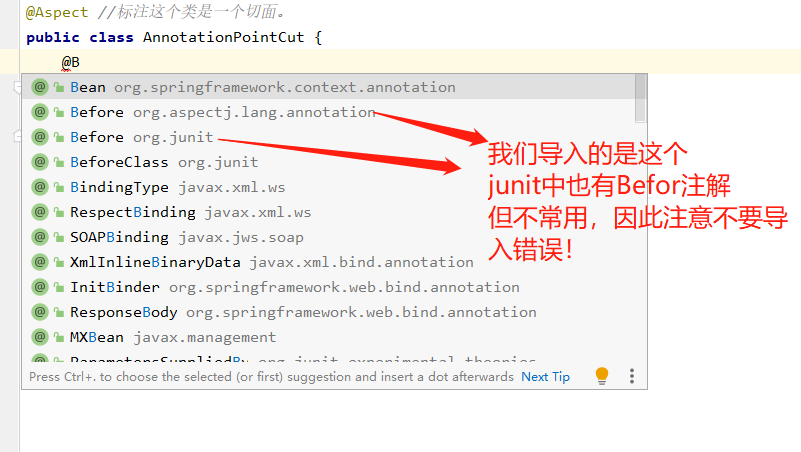
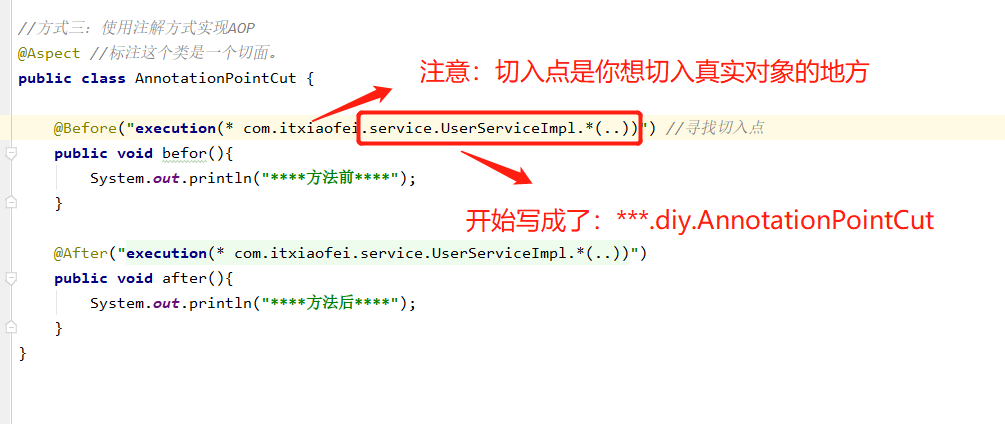
1.核心配置文件
<!--注册bean-->
<bean id="userService" class="com.itxiaofei.service.UserServiceImpl"/>
<bean id="log" class="com.itxiaofei.log.Log"/>
<bean id="afterlog" class="com.itxiaofei.log.AfterLog"/>
<!--方式三:使用注解实现AOP-->
<!--导入bean-->
<bean id="annotationPointCut" class="com.itxiaofei.diy.AnnotationPointCut"/>
<!--开启AOP注解的支持 JDK:默认(proxy-target-class="false") cglib(proxy-target-class="true") 两者都是一样的-->
<aop:aspectj-autoproxy proxy-target-class="false"/>
2.AnnotationPointCut
//方式三:使用注解方式实现AOP
@Aspect //标注这个类是一个切面。
public class AnnotationPointCut {
@Before("execution(* com.itxiaofei.service.UserServiceImpl.*(..))") //寻找切入点
public void befor(){
System.out.println("****方法前****");
}
@After("execution(* com.itxiaofei.service.UserServiceImpl.*(..))")
public void after(){
System.out.println("****方法后****");
}
//在环绕增强中,我们可以给定一个参数,代表我们要获取处理切入的点:
@Around("execution(* com.itxiaofei.service.UserServiceImpl.*(..))")
//ProceedingJoinPoint(签名)
public void around(ProceedingJoinPoint jp) throws Throwable{
System.out.println("~环绕前~");
Object proceed = jp.proceed();//执行方法
System.out.println("~环绕后~");
//获得签名
Signature signature = jp.getSignature();
System.out.println("signature:"+signature);
System.out.println(proceed);
}
}
3.测试
public class MyTest {
public static void main(String[] args) {
ApplicationContext context = new ClassPathXmlApplicationContext("ApplicationContext.xml");
//动态代理代理的是接口:注意点
UserService userService = (UserService) context.getBean("userService");
userService.update();
}
}
原文地址:http://www.cnblogs.com/itxiaofei/p/16834735.html
1. 本站所有资源来源于用户上传和网络,如有侵权请邮件联系站长!
2. 分享目的仅供大家学习和交流,请务用于商业用途!
3. 如果你也有好源码或者教程,可以到用户中心发布,分享有积分奖励和额外收入!
4. 本站提供的源码、模板、插件等等其他资源,都不包含技术服务请大家谅解!
5. 如有链接无法下载、失效或广告,请联系管理员处理!
6. 本站资源售价只是赞助,收取费用仅维持本站的日常运营所需!
7. 如遇到加密压缩包,默认解压密码为"gltf",如遇到无法解压的请联系管理员!
8. 因为资源和程序源码均为可复制品,所以不支持任何理由的退款兑现,请斟酌后支付下载
声明:如果标题没有注明"已测试"或者"测试可用"等字样的资源源码均未经过站长测试.特别注意没有标注的源码不保证任何可用性
